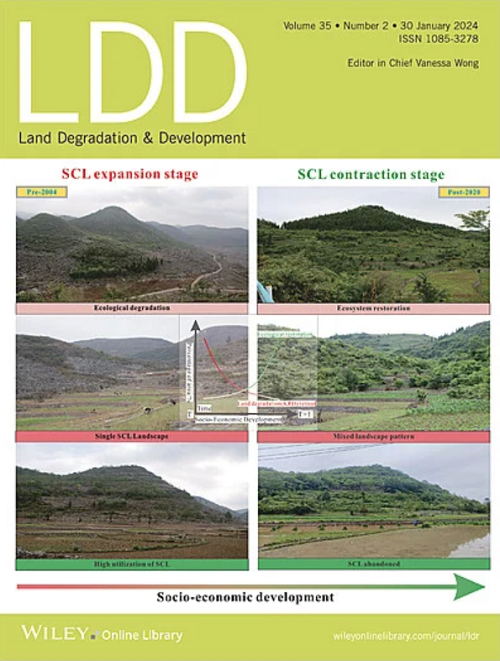秘鲁亚马逊东南部冲积金矿废渣土壤的退化、分类和管理
IF 3.6
2区 农林科学
Q2 ENVIRONMENTAL SCIENCES
引用次数: 0
摘要
个体矿工或资金有限的小型企业进行的手工和小规模采金业(ASGM)严重加剧了亚马逊地区的土地退化和生物多样性丰富的森林的丧失。由于有关对恢复这些退化地区至关重要的土壤条件的信息有限,我们在秘鲁亚马逊地区具有代表性的地点(包括两个原住民社区和一个自然保护区)采用了土壤评估方法。确认并验证了将手工和小规模采金业退化地区划分为文化景观单元的方法。哨兵-2 和无人机遥感显示,自 20 世纪 80 年代以来,毁林面积超过 122,000 公顷。地表和土壤剖面评估发现,新的土壤条件极差,化学和物理肥力低,质地粗糙,岩石破碎,阻碍了重新植被,尤其是在长期干旱季节。根据《土壤分类学》和《世界基准》,这些退化的土壤被归类为 Entisols 和 Technosols。随着时间的推移,自然再生和植树造林改善了土壤的形成,与公认的土壤分类系统保持一致。在当前的管理实践中,恢复规划应优先考虑选定的灌木和树种,并考虑使用土壤改良剂来启动土壤恢复。这种方法符合自我维持的演替阶段,有助于实现 "土地退化中性"、"适当的缓解和适应行动 "以及可持续发展目标。本文章由计算机程序翻译,如有差异,请以英文原文为准。
Degradation, Classification, and Management of Soils From Alluvial‐Gold Mine Spoils in the Southeastern Peruvian Amazon
Artisanal and Small‐Scale Gold Mining (ASGM) carried out by individual miners or small enterprises with limited capital, significantly contribute to land degradation and loss of biodiversity‐rich forests in the Amazon. Due to limited information on the edaphic conditions crucial for restoring these degraded areas, a soil evaluation method was employed in representative locations of the Peruvian Amazon, including two native communities and one protected natural area. The categorization of ASGM‐degraded areas into cultural landscape units was confirmed and validated. Sentinel‐2 and UAV remote sensing revealed over 122,000 ha of deforestation since the 1980s. Surface and soil profile assessments identified extreme new soil conditions with low chemical and physical fertility, characterized by coarse texture and rock fragments, which hinder revegetation, especially during prolonged dry seasons. These degraded soils were classified as Entisols and Technosols according to Soil Taxonomy and the World Reference Base. Over time, natural regeneration and plantations improved soil formation, aligning with recognized soil classification systems. Under current management practices, restoration planning should prioritize selected shrub and tree species, and consider soil amendments to initiate soil recovery. This approach aligns with self‐sustaining successional stages and contributes to the objectives of Land Degradation Neutrality, Appropriate Mitigation and Adaptation Actions, and Sustainable Development Goals.
求助全文
通过发布文献求助,成功后即可免费获取论文全文。
去求助
来源期刊

Land Degradation & Development
农林科学-环境科学
CiteScore
7.70
自引率
8.50%
发文量
379
审稿时长
5.5 months
期刊介绍:
Land Degradation & Development is an international journal which seeks to promote rational study of the recognition, monitoring, control and rehabilitation of degradation in terrestrial environments. The journal focuses on:
- what land degradation is;
- what causes land degradation;
- the impacts of land degradation
- the scale of land degradation;
- the history, current status or future trends of land degradation;
- avoidance, mitigation and control of land degradation;
- remedial actions to rehabilitate or restore degraded land;
- sustainable land management.
 求助内容:
求助内容: 应助结果提醒方式:
应助结果提醒方式:


